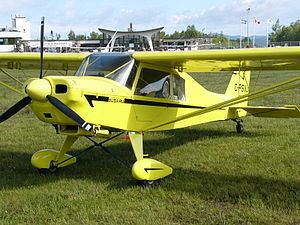 | ||
Norman aviation nordic vii taxiing and takeoff csu3
The Norman Aviation Nordic VII is a Canadian advanced ultralight aircraft, that was designed by Jacques Norman and produced by Norman Aviation of Saint-Anselme, Quebec. The aircraft was supplied as a kit for amateur construction or as a complete ready-to-fly-aircraft.
Contents
- Norman aviation nordic vii taxiing and takeoff csu3
- Norman aviation nordic vii advanced ultralight touch and go csu3
- Design and development
- Operational history
- Specifications Nordic VII
- References
Production is complete and the Nordic VII is no longer available.
Norman aviation nordic vii advanced ultralight touch and go csu3
Design and development
The Nordic VII was designed to comply with the Canadian ultralight rules. It features a strut-braced high-wing, a two-seats-in-side-by-side configuration enclosed cockpit with doors, fixed conventional landing gear and a single engine in tractor configuration.
The aircraft fuselage is made from welded steel tubing, with its wings made from wood and all surfaces covered in doped aircraft fabric. Its 33.80 ft (10.3 m) span wing has an area of 135 m2 (1,450 sq ft) and mounts flaps. The wing is supported by V-struts and jury struts. The standard engines supplied were 90 to 100 hp (67 to 75 kW) Subaru EA four-stroke powerplants.
The cockpit width is 41 in (104 cm), 2 in (5.1 cm) wider than the Nordic II. The Nordic VII also has a swept tail, which differentiates it from the Nordic VI. The wing has slightly greater span than the Nordic VI, but less area, giving the Nordic VII a 5 mph (8.0 km/h) higher stall speed and a lower rate of climb, but a faster cruise speed.
Construction time from the factory supplied kit is estimated at 300 hours.
Operational history
In November 2016 there were two Nordic VIIs on the Transport Canada Civil Aviation Register.
Specifications (Nordic VII)
Data from Purdy
General characteristics
Performance
